Posted by Anita on 01.25.08 10:34 PM
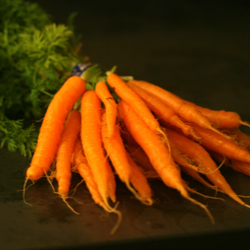 We haven’t gone in much for New Year’s resolutions this year, but we are making a few small changes. As part of our Dark Days Challenge (and as a side effect of finally finishing reading Omnivore’s Dilemma, two years behind the curve) we’re moving more of our food-budget dollars around. We’d already dabbled a bit in acclimating our palates to grass-fed beef, and we’re going to get more serious about it this coming year.
We haven’t gone in much for New Year’s resolutions this year, but we are making a few small changes. As part of our Dark Days Challenge (and as a side effect of finally finishing reading Omnivore’s Dilemma, two years behind the curve) we’re moving more of our food-budget dollars around. We’d already dabbled a bit in acclimating our palates to grass-fed beef, and we’re going to get more serious about it this coming year.
But possibly the largest change — one that has an effect on something we eat literally every day — is making the switch to pastured eggs. As I mentioned in the comments to our last Dark Days post, I finally decided that spending the extra cash for ethically raised eggs was really not going to put a huge dent in the food budget. But man, $7 a dozen feels extravagant when you’ve been spending $2.25 for quasi-organic eggs.
Which brings me to one of my first food discoveries of the new year: Just because you buy your eggs from a joke-cracking fella at the Ferry Plaza market doesn’t mean they’re ethically raised. (If you get your eggs from Judy’s Family Farm or any of the other eggs at the stand across from June Taylor, do yourself a favor and click that link.) Needless to say, I was pretty pissed off to discover that I’d been duped by what Michael Pollan might call “farmers market pastoral.” It took a dose of righteous anger to open my eyes: A $5-per-week premium isn’t outrageous. It’s a tiny fraction of our food budget, and a drop in the bucket compared to the cost buying of ethically farmed meat.
 With that little surprise under my belt, I reluctantly started digging deeper into the true origins of other items that I’d previously assumed were sustainably produced. Much to my pleasant surprise, Clover Organic and a number of other brands I suspected might be greenwashing were entirely on the level. (I’m not sure whether I was more shocked by my egg supplier’s betrayal or the honesty of one of the area’s largest dairies.)
With that little surprise under my belt, I reluctantly started digging deeper into the true origins of other items that I’d previously assumed were sustainably produced. Much to my pleasant surprise, Clover Organic and a number of other brands I suspected might be greenwashing were entirely on the level. (I’m not sure whether I was more shocked by my egg supplier’s betrayal or the honesty of one of the area’s largest dairies.)
But back to the sunny side: Putting together Dark Days meals continue to feel far too easy. Our summer of canning, salting, freezing, and otherwise preserving the harvest is paying off in spades; sometimes dinner’s as simple as opening the freezer, thawing a bag of protein, and heating up a starch and a farmers market vegetable to go alongside.
We’ve also managed to add a number of new local items to our roster of ingredients. In the first half of the month, we sourced Liberty duck from Sonoma County Poultry (Penngrove – 48 miles); Giusto’s flour and baking soda (South San Francisco – 8 miles), and of course those Eatwell Farm pastured eggs (Dixon – 67 miles).

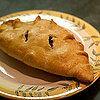
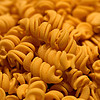
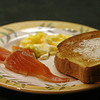
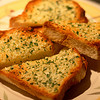
Dark Days Ticker — January 1-15
– Dark Days dinners: 7 (out of 15)
– New recipes: Duck burgers, country-fried steak, Cornish pasties
– Old faves: One-day cassoulet (leftovers)
– Freezer fodder: Chile verde tacos; gravlax; linguine Bolognese; fusilli marinara
Dark Days challenge, locavore, shopping
13 Comments »




Posted by Anita on 01.25.08 7:03 AM
 Last weekend’s do-it-yourself bubbly bar was a source of great amusement for our guests. Aided by a handy cheat-sheet, the crew whipped up Kir Royales and Champagne Cocktails and Death in the Afternoons aplenty. For the teetotalers, we also offered an assortment of homemade syrups and alternative sparklers — Seltzer Sisters soda water and two kinds of ginger ale — along with suggestions for non-alcoholic spritzers.
Last weekend’s do-it-yourself bubbly bar was a source of great amusement for our guests. Aided by a handy cheat-sheet, the crew whipped up Kir Royales and Champagne Cocktails and Death in the Afternoons aplenty. For the teetotalers, we also offered an assortment of homemade syrups and alternative sparklers — Seltzer Sisters soda water and two kinds of ginger ale — along with suggestions for non-alcoholic spritzers.
One of my favorites in this category is the venerable Horse’s Neck, a deceptively simple combination of a ginger ale and long strip of lemon zest that dates to the late 1800s. Popular though the soft drink was, it didn’t take long for clever barkeeps to fortify it. As early as 1897, columnists allowed that “a dash of whisky is said not to interfere with the agreeable taste of this drink.” By the turn of the century, the once-optional shot was nearly a foregone conclusion, although the original recipe enjoyed a revival of sorts during the temperance years.
The boozed-up version — known as a “Horse’s Neck with a Kick” or a “Stiff Horse’s Neck”, depending on which mixology manual you consult — adds an ounce or two of your favorite brown liquor to the glass. Most recipes call for whiskey of some sort, but you find occasional mentions of brandy or even gin. Wander a little further afield, and it’s not too hard to see the hoofprints in similar beverages: Swap rum for whiskey and a lime wedge in place of the lemon twist, and you’ve got a Dark & Stormy. Substitute vodka, and you’re 2/3 of the way to a Moscow Mule — even the name is a clue!





Horse’s Neck with a Kick
1-1/2 to 2oz bourbon or rye
ginger ale
bitters
lemon zest
Place a long, continuous spiral of lemon zest in a Collins glass, hooking one end over the rim to keep it from sinking. Fill the glass with ice, add the bourbon and a few shakes of bitters, and top with ginger ale.
1 Year Ago — DOTW: Bobby Burns
Drink of the Week, drinks, recipes
6 Comments »




Posted by Anita on 01.24.08 2:22 PM
 I may be the only foodie on the planet who doesn’t dig duck. I love the glorious seared breast they’ve been known to serve at Seattle’s Union, and we’ll pick up the occasional leg of confit for salads or cassoulet. I don’t actively dislike it, but duck’s not the kind of food I generally crave.
I may be the only foodie on the planet who doesn’t dig duck. I love the glorious seared breast they’ve been known to serve at Seattle’s Union, and we’ll pick up the occasional leg of confit for salads or cassoulet. I don’t actively dislike it, but duck’s not the kind of food I generally crave.
All that may be changing. On our recent trip to Napa, Cameron ordered the famous duck burger at Cindy’s Backstreet Kitchen. It smelled so heavenly that I had to try a taste. Needless to say, the combination of sweet, spicy, and smoky goodness made a lasting impression on me; as soon as we got home, I flipped open our copy of Big Small Plates to hunt down the details.
I found it easily enough, but the complexity of reproducing this dish was enough to make my eyes roll back in my head. The recipes, plural, went on for pages and pages — and that didn’t even count the marinade found in a separate part of the book. Ugh. But the flavor of that burger was haunting me… and besides, what better way could there be to spend a lazy Saturday afternoon?
Truth be told, the prep wasn’t all that difficult, or even time-consuming. There’s a lot of measuring and mixing, but that’s about it. We weren’t wowed by the original mustard sauce sub-recipe, however; it took too much time, dirtied too many dishes, made enough spread for a dozen burgers, and ended up tasting no better than a much easier substitution: store-bought honey mustard mixed with a touch of creme fraiche.
If you can find pre-ground duck for this recipe, things get even easier; some Whole Foods locations offer it, and any decent butcher should grind duck-leg meat (or any meat you want, for that matter) on request. Bizarrely, the recipe says you need two whole ducks at 4 pounds each — 8 pounds of bone-in duck!? — to make 1 pound of ground meat. Holy duck! Instead, we purchased 4 whole duck legs — about 1-3/4 pounds total weight, before boning — and ran the meat, fat, and a small amount of skin through our KitchenAid grinder. We ended up with exactly 1 pound of ground meat.

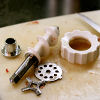
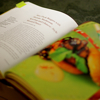
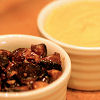
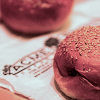
Cindy’s Famous Duck Burgers
– adapted from Big Small Plates
Patties
1 pound ground duck (see note in text above)
1 scallion, white and tender green parts, minced
1 tsp grated fresh ginger
1-1/2 tsp minced garlic
1T Mongolian marinade (see below)
1 tsp salt
1/4 tsp black pepper
Mustard Sauce
2T spicy honey mustard
2T creme fraiche
Shiitake Ketchup
2T olive oil
1 pound shiitake mushrooms, stemmed and quartered
1 onion, diced fine
1/2 tsp salt
1/2 tsp pepper
1/4 cup balsamic vinegar
2 tsp minced garlic
2 T molasses or dark honey
1/4 cup Mongolian marinade (see below)
To Finish
1 cup arugula
3 or 4 egg-sesame hamburger buns
Combine patty ingredients in a large bowl. Refrigerate duck mixture while making remaining components — at least 1 hour, or overnight.
Whisk the honey mustard and creme fraiche in a small bowl. Refrigerate until serving time.
Saute the mushrooms in a skillet with the oil over medium-high heat, cooking until tender. Add the onions and cook until translucent. Add the remaining ingredients, stirring well to combine, and simmer 3 to 5 minutes, until the sauce coats the mushrooms.
Portion the meat into 1/4- to 1/3-pound patties. Grill the burgers over a medium-hot fire, or broil in the oven, to medium rare — about 4 minutes on the first side, and 2 on the back — or to taste.
While burgers are cooking, toast the hamburger buns. Spread some of the mustard sauce on the bottom half of the bun. Top with the cooked burger, then the shiitake ketchup and arugula. Top with the other bun half, and serve.
—–
Mongolian Marinade
1/3 cup hoisin sauce
1-1/2 tsp sugar or honey
2 tsp tamari
2 tsp sherry vinegar
1 medium scallion, white and light green parts, minced
1/2 tsp Tabasco sauce
1/2 tsp black bean chili paste
1 tsp grated fresh ginger
2 tsp minced garlic
1/4 to 1/2 tsp ground white pepper
2T minced cilantro
1-1/2 tsp sesame oil
Whisk all ingredients together and set aside.
(Leftover marinade keeps for 3 to 6 months in the freezer, and works well on chicken or pork chops, too.)
cookbooks, locavore, recipes
10 Comments »




Posted by Anita on 01.18.08 7:09 AM
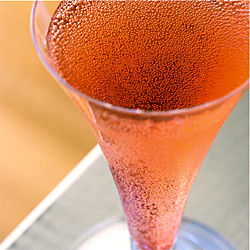 In the pantheon of sparkling cocktails, there are a thousand lesser gods, and then there are the titans: the bright Mimosa, the elegant Champagne cocktail, the tart French 75, and the dusky Kir Royale. They’re generally a subtle lot, and so simple to make that you hardly need a recipe. They’re all lovely in their own ways and moods — Mimosas at brunch, Champagne cocktails at weddings, French 75s when you want to get into an argument about gin vs. brandy — but the Kir Royale is perhaps the most adaptable.
In the pantheon of sparkling cocktails, there are a thousand lesser gods, and then there are the titans: the bright Mimosa, the elegant Champagne cocktail, the tart French 75, and the dusky Kir Royale. They’re generally a subtle lot, and so simple to make that you hardly need a recipe. They’re all lovely in their own ways and moods — Mimosas at brunch, Champagne cocktails at weddings, French 75s when you want to get into an argument about gin vs. brandy — but the Kir Royale is perhaps the most adaptable.
Until it was popularized by Catholic priest Félix Kir, the simple aperitif of white wine and blackcurrant liqueur was known quite aptly as blanc-cassis throughout its native Burgundy. But then, history intervened. An active organizer in the Resistance during World War II, Monsieur Kir helped plan the escape of more than 5,000 prisoners of war. After the Liberation, Kir was elected mayor of Dijon — the Burgundian capital — and eventually took his place in the French national assembly. He was the last clergy member to wear the habit in the halls of the Palais Bourbon, and he always toasted delegations visiting Dijon with the aperitif that perfectly marries two of the town’s best tipples.
The original Kir is made by dosing white wine — not, as some would say, Burgundy’s reknowned Chablis, but rather the slightly sour Aligoté — with Dijon’s equally famous blackcurrant liqueur, creme de cassis. The Kir Royale makes things a bit more festive by replacing the white wine with Champagne, an inspired substitution that moves an everyday apero into the realm of celebratory cocktail.
The Kir Royale also makes a perfect party drink, as it’s low in alcohol — best for guests who may not be accustomed to knocking back a few high-octane libations in an evening — and quite forgiving of measurement-free mixing. After all, what host wants to spend time fiddling with precisely a half-ounce of this and exactly three shakes of that when there are guests to greet, coats to hang, conversation to encourage, and appetizers to primp?
We’re having a few friends over for cocktails and canapés tomorrow night, and one of the ways we’re planning to keep things simple is by setting up a do-it-yourself Champagne bar. We’ll put a case of bubbly on ice, line up a couple dozen flutes, and gather a gaggle of colorful liqueurs — cassis, St-Germain, absinthe, violette, Chartreuse — for guests to customize their drinks. We’ll have syrups, garnishes, and bitters, too, plus a sheet with ideas on how to mix and match. It’ll be fun to see an assortment of pastel sparklers in the hands of our pals; I can’t wait to see what our clever friends concoct.

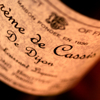




Kir Royale
1/4 to 1/2 ounce crème de cassis (or to taste)
Champagne or other dry sparkling wine
Pour the cassis into the flute, and top with the bubbly.
Garnish with a lemon twist, if desired.
Drink of the Week, drinks, entertaining, recipes, wine & bubbly
20 Comments »




Posted by Anita on 01.13.08 2:08 PM
 Suffice to say that we had such a relaxing time on our vacation that it’s taking us an inordinately long time to get back in the swing of things. We’ve been home nearly 2 weeks now, and I am finally getting my head out of the clouds long enough to tell you about all the gorgeous food we ate.
Suffice to say that we had such a relaxing time on our vacation that it’s taking us an inordinately long time to get back in the swing of things. We’ve been home nearly 2 weeks now, and I am finally getting my head out of the clouds long enough to tell you about all the gorgeous food we ate.
Our 10 days away — in a little cottage in the foothills above Napa Valley — were incredibly relaxing. We brought along two coolers full of food from the farmers market (our landlord eyed the back of our car and quipped, “You know, we do have grocery stores here…”) and we spent nearly every day sitting by the fire, catching up on our reading, and cooking amazing food.
The day we drove up, we bought a pair of enormous Dungeness crabs from Shogun fish on their last market day of the season. The first night in our little cottage, Cameron picked the crabs and we sauteed the meat in Spring Hill Farm butter along with some zest from our backyard lemons and a few slices of green onions. Served over Eduardo’s linguine, with a salad and a split of Schramsberg sparkling wine, it was the perfect settling-in meal.
Of course, there was plenty of leftover crab meat! The next day, we turned part of it into crab omelettes for brunch, then mixed the rest into a sumptuous batch of fondue mac-and-cheese. Monday night, we whipped up a 100% local batch of Jen’s chicken cacciatore with an heirloom chicken from Prather and some Far West Funghi chanterelles, served over Full Belly Farm polenta with a bottle of Calistoga Cellars Zinfandel.
Tuesday night was Christmas supper: Mini beef Wellingtons! Prather Ranch filet mignon wrapped in puff pastry with a slice of Fatted Calf foie gras and duxelles made from Far West cremini mushrooms, Spring Hill butter, and Straus cream. On the plate: A sauce of red-wine-infused demiglace (homemade from Prather bones) and a side of Iacopi green beans quick-braised with Fatted Calf pancetta. We drank a bottle of Cabernet from Mount Veeder Winery, just a few miles down the road from our cottage.
Wednesday night, we turned to our usual lazy-day standby: Pasta Bolognese with a big green salad. Thursday we took the night off from kitchen duty, and headed down the hill for a gorgeous sushi-fest at Go Fish. By Friday, we were ready to cook again: We pulled the last of our homemade spiral sausage out of the freezer and served it along with cauliflower soup made from farmers market veggies and a mixture of orphan pieces from the local cheese plate we’d been nibbling all week.
Saturday night Cameron made an improvised braise of Prather beef cheeks, with homemade beef stock, home-canned tomatoes, and herbs from the garden. Served with more Full Belly polenta and some Ella Bella broccoli rabe, it was the perfect supper for the chilliest night of our trip.
Sunday night, we began prepping our traditional New Year’s cassoulet. While the stovetop was occupied simmering Rancho Gordo beans, searing Toulouse sausages, and cooking off Fatted Calf duck confit, we used the oven to roast a most gorgeous Range Brothers pork rib roast. An unorthodox recipe for potato gratin — started on the stovetop and finished in the oven while the roast rested — turned out beautifully… a perfect showcase for Little’s potatoes, Bellwether Farms cheese, and Clover dairy. We usually roast our Brussels sprouts, but because our baby oven couldn’t accommodate a roast and a side dish, we tried a new-to-us method: Sauteeing the shredded sprouts in rendered pancetta fat, and adding the crisped pork back to the finished dish at the end. (We loved it so much, we’re having it again tonight.)
Monday night — New Year’s eve — meant it was finally time to break into the cassoulet that had been tempting us with its luscious smells for the last 24 hours. A rough-but-tasty bottle of Pinot Noir and a big salad were all we needed to round out its delicious pork-infused goodness.
Packing the next morning was almost impossibly hard; our little kitchen had served us so well for our 10 days away! Unlike most rental houses, this one was well stocked with high-end cookware and thoughtful staples (organic eggs and Bouchon pastries awaited us our first morning). But the ultimate luxury was having the time to putter in the kitchen all day, every day. The space was cozy, and the equipment a bit spare, but it was such a treat to forget about the office, the phone, and all of our usual distractions for a few days and cook together.
We planned all along to keep up with the Dark Days challenge while we were gone, but looking back over our photos, we were surprised at just how well we’d done. With the exception of cocktails, a few lunches out, and our one in-town dinner, everything we ate and drank during our trip came from local sources. Getting to the 90% local, five-nights-a-week mark has become pretty achievable for us on a regular basis. It’s comforting to know we could get to 100% local — given unlimited time to plan, to shop, to cook — even if it’s not something we’re able to do in the workaday world.
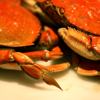
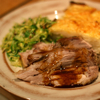

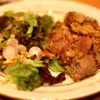
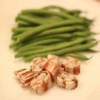
Now, in theory, the Dark Days challenge wrapped up at the end of last year, with an optional extension into 2008. We’re having such a ball, we’ve decided to continue with the challenge, along with more than 20 other participants. Because our hostess, Laura, is in the midst of moving her house (and her chickens!), official wrap-ups will taper off to every two weeks.
Because it’s a new year, we’re going to make some changes to our own ground rules, too. Here’s our revised game-plan:
- We will continue to cook locally as often as we can, with a baseline of two dinners per week made from 90% local ingredients.
- We will write about
at least two meals a week made with as many local ingredients as we can source. our locavore adventures regularly, but we’re going to dispense with the litany of meals and sources, as it’s getting rather repetitious and a bit boring for non-locavore readers. We WILL talk about new pantry items, new farmers we’ve discovered, and recipes for in-season items within our foodshed.
- Local for us will be a 100-mile radius for produce and a 200-mile radius for protein. We will try to keep our protein within a 50- to 100-mile radius at least twice a week. Strong preference will be given to items purchased directly from farmers at market rather than retail. Our protein will include pastured eggs, poultry, and pork, as well as grass-fed beef. When grass-fed is not available or not appropriate, we will use 100% humanely raised, pastured beef. (I find grass-fed beef too gamey in grilled or stir-fried preparations, but for braises and stews, it’s our new default.)
- We’re making the usual ‘Marco Polo’ exemptions for seasonings.
We’re also making exceptions for flour, dried pasta, white rice, and polenta — we have no local sources of these ingredients, and man does not live by potatoes and bread alone. We will try to source baking ingredients locally, but I don’t expect to find much beyond nuts, and I won’t go through the holidays without baking. (We’ve found local sources for all of our grains.)
- We’ll try to limit processed and prepared foods to those produced within a 50-mile radius. We’ll try to determine how much local ingredient sourcing they’re doing, and talk about it in our posts.
- We’ll continue with the challenge through the end of
the year, and then re-evaluate on New Year’s Day along with other participants. March.
Dark Days challenge, locavore, Napa & Sonoma, travel
6 Comments »




Posted by Anita on 01.11.08 9:27 PM
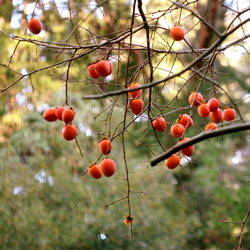 Our fave spot Range has been closed for a post-New Year holiday break so we had no idea anything was amiss. But, tonight we read on 7×7’s Buzzed blog that head bartender Brooke Arthur has been hospitalized since New Year’s Eve due to severe smoke inhalation and burns, the result of a fire in her apartment.
Our fave spot Range has been closed for a post-New Year holiday break so we had no idea anything was amiss. But, tonight we read on 7×7’s Buzzed blog that head bartender Brooke Arthur has been hospitalized since New Year’s Eve due to severe smoke inhalation and burns, the result of a fire in her apartment.
Although she probably wouldn’t know us from Adam, Brooke’s amazing cocktail program is one of the many reasons we spend an inordinate amount of our dining budget at Range every month; we even featured one of her creations on Drink of the Week last summer.
In addition to some mind-bending hospital bills — she’s in an intensive burn unit, and unable to breathe on her own at this point, according to the page her family’s updating — Brooke also lost most everything in her apartment to the fire. Duggan and the boys at Cantina are hosting a benefit for Brooke’s expenses this coming Monday night. If you’re a fan of Range’s bar program, or even if you need a worthy excuse for an early-in-the-week cocktail, please join us there.
If you’re unable to come, or simply prefer to donate to Brooke’s family directly, please visit Brooke’s site.
—–
UPDATE 1/15: Last night’s benefit at Cantina was a jam-packed success. Even better news from Marcia at Tablehopper: A star-studded cast of Range alums — including Dominic and Camber — are picking up Brooke’s shifts while she’s convalescing. On Tuesdays and Thursdays (yay, our regular nights!) the restaurant will match all bar tips, donating them to a fund for Brooke’s medical bills and lost income.
bar culture, giving back, other stuff
1 Comment »




Posted by Anita on 01.11.08 4:30 PM
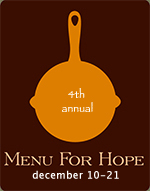 Oh, boy! The winners of the Menu for Hope raffle have been announced. Check out Pim’s giant list of all the winners to see what you won.
Oh, boy! The winners of the Menu for Hope raffle have been announced. Check out Pim’s giant list of all the winners to see what you won.
I’m tickled pink that local food-and-spirits maven Jane Tunks won our custom mixology service prize — we’ll be bringing Drink of the Week to Jane’s house sometime soon, mixing up a pair of signature cocktails for a dozen of her swellest pals.
And our blog-buddy Lara, one of the blogosphere’s all-time most-fabulous food photographers, won the Drink of the Week notecards on the same month she picked beverages as her Still Life With… challenge theme. Spooky, eh?
Lest you think we fixed all of the results, I’m relieved to announce that a total stranger — Lauren Kawakami — won our “Best of the Ferry Building” basket. (Ms. K, if you’re out there, please drop a note to chef -at- marriedwithdinner -dot- com, with your mailing address, and we’ll get your prize in the post ASAP.)
Can you believe we raised $91,188 for the UN World Food Programme? That’s an astounding success! Thank you, again, to everyone who participated in the raffle. I can’t wait to see what next year’s Menu for Hope has in store.
Menu for Hope
Comments Off on Win-win-win scenario




Posted by Anita on 01.11.08 7:48 AM
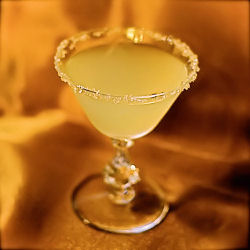 Invented in France during the years of America’s “noble experiment†with Prohibition, it’s puzzling that the Sidecar has yet to take its proper place in the modern cocktail renaissance. It’s a glorious drink when well made, but it does subject the bartender to a little bit of fuss.
Invented in France during the years of America’s “noble experiment†with Prohibition, it’s puzzling that the Sidecar has yet to take its proper place in the modern cocktail renaissance. It’s a glorious drink when well made, but it does subject the bartender to a little bit of fuss.
As with many simple drinks, the quality of the ingredients can make or break this recipe; Robert Hess does an excellent job detailing the contributions of the various components. But even when using top-shelf brands, you’ll need to do a fair bit of balancing. Brandies vary widely in strength and sweetness, and even plain-old Eureka lemons change in acidity throughout the growing season.
The traditional recipe of equal parts brandy, triple-sec, and lemon juice is very sweet, especially when served in the customary sugar-rimmed glass. Although I won’t go as far as David Embury — who rationalized that a Sidecar is simply a Daiquiri clone, and advocated a bone-dry ratio of 7:2:1 — I do think that all but the sweetest palates will prefer something closer to two parts brandy to one part each Cointreau and juice.
Like many old-time recipes, the Sidecar has undergone a dizzying list of modifications over the past 70 years. Beyond modernizing the proportions, this recipe stands up to a fair bit of tinkering. Varying the base liquor gets you a Chelsea Sidecar (gin), a Boston Sidecar (rum plus brandy), or an Applecar (Applejack). Swapping lime juice for the lemon, or tweaking Cointreau for another liqueur yields even more alternatives.

For this month’s Mixology Monday — a Brandy theme, hosted by the lovely Marleigh at over at Sloshed! — we took our inspiration from a drink we enjoyed at Cindy’s Backstreet Kitchen. The menu listed Belle de Brillet pear Cognac in place of the brandy (and you know we loves us some of that). Alas, the resulting mixture was jaw-numbingly sweet, but the concept was just too good to ignore; off we went to the home laboratory.
First we tried decreasing the sweet components: Reducing the Belle de Brillet diminished the beautiful pear essence of the drink, and halving the Cointreau flattened everything out. Starting out from the other direction, increasing the lemon juice made things too puckery. Dispensing with the sugared rim did help a bit, but it seems a shame to lose this sparkle.
At last, we turned to the Clear Creek Pear Brandy (or, better still, its sibling eau de vie in the captive-pear bottle). Hooray! We’d found plenty of pear and fruity warmth without the cloying sweetness.



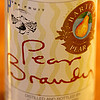


Le Side-car aux Poires
1-1/2 oz pear brandy
3/4 oz Cointreau
3/4 oz lemon juice
Before squeezing the lemon, rub the cut side along just the outside edge of a chilled cocktail glass. (Resist the urge to dip the rim in water or juice — as you see sloppy bartenders do just about everywhere — or you’ll end up with sugar inside the glass and floating in your drink.) Dip the edge into a plate of sugar, rolling to create a sugar rim.
Shake the brandy, Cointreau, and juice with ice. Strain into the prepared cocktail glass.
Drink of the Week, drinks, Mixology Monday, recipes
11 Comments »




Posted by Anita on 01.09.08 8:03 AM
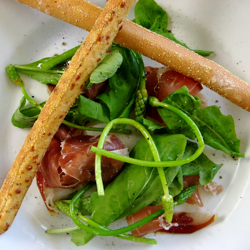 Once upon a time, there was a Chef who toiled away in other people’s kitchens. After gaining acclaim for a rare skill with classic preparations, the Chef moved to Napa Valley and opened a signature restaurant on the fringe of the sleepy village of Yountville.
Once upon a time, there was a Chef who toiled away in other people’s kitchens. After gaining acclaim for a rare skill with classic preparations, the Chef moved to Napa Valley and opened a signature restaurant on the fringe of the sleepy village of Yountville.
Soon, visitors flocked to the Valley not just to drink, but also to dine. An award-winning cookbook soon followed, then another cozier restaurant just down the road. The ensuing years brought more praise from the press, another cookbook, still more awards. Never content to rest on culinary laurels, the Chef recently opened a third restaurant aimed at a broader audience.
Think that you know this story? Not so fast. The hero of this particular tale is a woman, and the plot begins not in 1997 at The French Laundry with Thomas Keller, but in the dark ages of 1983 at a “truck stop deluxe” along Highway 29 known as Mustards Grill.
Before making history at Mustards, Cindy Pawlcyn made her name at the once-enthralling (but now sadly coasting) Fog City Diner. One of the first to popularize the conceit of comfort food as true cuisine, FCD was among the vanguard of New American restaurants. Pawlcyn was praised for her efforts there, and the cookbook she wrote remains a classic of the comfort-luxe genre.
When Pawlcyn took her jumped-up homespun specialties to Yountville, the national press knew she was onto something special. “[Mustards] changed Napa Valley and took the stuffiness out of dining,” said Gourmet magazine. Pawlcyn was soon in high demand, serving as chef and/or consultant to a string of well-known ventures, including San Francisco’s Bix, Marin’s Buckeye Roadhouse and Napa’s Tra Vigne. The Mustards Grill Napa Valley Cookbook won a James Beard Award, and it remains a perennial favorite in our kitchen (and many others, to judge from our friends’ bookshelves).
Pawlcyn eventually sold her share in the Real Restaurants empire to focus solely on Mustards, but with the 2001 takeover of St. Helena’s Miramonte, she again became a multi-location chef. Morphing into the less-threatening Cindy’s Backstreet Kitchen in 2003, this outpost continues to draw crowds — a happy success in a region where fickle diners often disappear as quickly as they came.
—-
We’ve eaten at most of Cindy Pawlcyn’s restaurants, including a good dozen visits to Mustards over the years, although a recent lunch there with family left me wondering if the 25-year-old landmark was feeling its age. The four of us ordered an assortment of options; none of our choices really wowed, and a few truly bombed. Months later, I grimace to recall a plate of greasy onion rings, and a pulled-pork sandwich with bland meat under a nearly inedibly sweet, heavily spiced sauce.
Happily, Pawlcyn’s two other ventures are as good as Mustards ever was in its prime.
We’ve returned to Cindy’s Backstreet Kitchen three times in as many trips north — twice last summer, and then once again last month. The food is old-school American with judicious flashes of Asian and Latin spark. If, like me, you’re a fan of Pawlcyn’s latest cookbook, Big Small Plates, you’ll find yourself equally taken with the dining room where many of its recipes first appeared. The decor evokes a gorgeous farmhouse, with a California crispness and vibrant splashes of Wine Country color. A long bar forms the centerpiece of the front dining room, a metaphor brought home by a clever cocktail list that weaves farm-fresh produce into a collection of delectable drinks.
In early 2007, Pawlcyn launched what is now her largest outpost: Go Fish. A “West Coast seafood house” along Highway 29, Go Fish is paradoxically cavernous but cozy, a coup that owes much to successful decor and lighting. The menu includes both traditional and modern seafood plates, but — as you might expect from a kitchen under the auspices of sushi master Ken Tominaga — the raw fish options are its stunning centerpiece. We visited over the holiday and out of a dozen nigiri and a few specialty rolls we sampled, only one (the kitchen’s very last portion of ikura, which we should have known better than to pounce upon) was less than sublime.
As lovely as Go Fish is, though, it’s too dear for everyday. It’s all too easy to spend hundreds of dollars on dinner for two, especially if you make a meal of the amazing sushi… which I highly suggest you do. Happily, there are many different ways to experience the inspired cuisine of the other — one might even say the original — Napa dining dynasty.
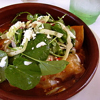
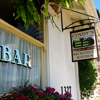

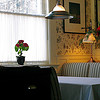
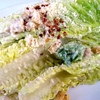
Cindy’s Backstreet Kitchen
1327 Railroad Avenue
St. Helena, CA 94574
707.963-1200
Go Fish
641 Main Street
St. Helena, CA 94574
707.963-0700
Mustards Grill
7399 St. Helena Highway
Yountville, CA 94558
707.944-2424
cookbooks, Napa & Sonoma, restaurants
5 Comments »




Posted by Cameron on 01.04.08 7:03 AM
 It sometimes seems like Dean & DeLuca‘s mission is to curate the world’s most eclectic collection of foodie curios. A trip through the aisles of the Napa Valley outpost can feel like a visit to Ripley’s Believe It Or Not! museum (“Oh look! Salt-cured hummingbird tongues packed in oil from Madagascar!”).
It sometimes seems like Dean & DeLuca‘s mission is to curate the world’s most eclectic collection of foodie curios. A trip through the aisles of the Napa Valley outpost can feel like a visit to Ripley’s Believe It Or Not! museum (“Oh look! Salt-cured hummingbird tongues packed in oil from Madagascar!”).
Of course, one of the great pleasures of cruising through such an outlandish assortment is that you occasionally run across something fabulous that’s incredibly difficult to find — like a bottle of Schweppes Indian Tonic Water. The regular Schweppes tonic is a staple in nearly every grocery store, but the drier Indian Tonic is all but unavailable in the States. Why the excitement? Until we sampled Fever Tree, I considered the rarely seen Schweppes Indian the sine qua non of tonic. Just as we grabbed a bottle from the cold case in order to see if was as good as we remembered, we spotted a 4-pack of Q Tonic, a newish brand that we’d heard of but not yet tried. Clearly the Fates had intervened, and another taste test was in order.
We set up the Schweppes Indian and the Q Tonic alongside a bottle of Fever Tree — the winner of our last tonic roundup — tasting each alone and mixed in a gin and tonic. Sweetened with glucose-fructose syrup and sugar, the Schweppes Indian tasted the most like the commercial American tonic waters, minus the nasty chemical aftertaste of high-fructose corn syrup. Its only drawback was a pronounced citrus finish that we found distracting. Next up, the Q Tonic had a light golden hue which may come from the agave syrup used as its sweetener. Bone dry, impossibly subtle, and with very little finish on the palate, the Q Tonic made for a somewhat flavorless G&T. If you’re tired of being bowled over by sugary, strongly-flavored tonic waters, you may enjoy the Q Tonic, but it left us unsatisfied.
Our favorite tonic remains the Fever Tree; we like the balance between bitter and sweet, the soft touch of cane sugar, and the occasional hints of spice.





After revisiting the land of quinine, it seems only fitting to propose a tonic-based beverage for Drink of the Week. But since we’ve already covered the Gin & Tonic, and the Tequila & Tonic — and given that we refuse to consider Vodka-Tonic an actual drink — it seemed like we’d run out of options.
Luckily, CocktailDB rode to the rescue. The Granada seems like an oddball combination, but it’s surprisingly balanced and quite refreshing. Its relatively low alcohol content makes it a good option for cocktail parties, or perhaps a post-chores refresher on those Saturdays when a cold beer just seems too heavy or malty. It’s zippy and a little spicy, and the quinine’s bite cuts through the sweetness of the orange liqueur while playing off its bitter-orange notes to a T.
Granada
1 oz brandy
1 oz dry sherry
1/2 oz orange curaçao (such as Cointreau)
Shake together with ice, and strain into an ice-filled highball glass. Top with tonic, and serve.
Drink of the Week, drinks, recipes
6 Comments »




 We haven’t gone in much for New Year’s resolutions this year, but we are making a few small changes. As part of our Dark Days Challenge (and as a side effect of finally finishing reading Omnivore’s Dilemma, two years behind the curve) we’re moving more of our food-budget dollars around. We’d already dabbled a bit in acclimating our palates to grass-fed beef, and we’re going to get more serious about it this coming year.
We haven’t gone in much for New Year’s resolutions this year, but we are making a few small changes. As part of our Dark Days Challenge (and as a side effect of finally finishing reading Omnivore’s Dilemma, two years behind the curve) we’re moving more of our food-budget dollars around. We’d already dabbled a bit in acclimating our palates to grass-fed beef, and we’re going to get more serious about it this coming year. With that little surprise under my belt, I reluctantly started digging deeper into the true origins of other items that I’d previously assumed were sustainably produced. Much to my pleasant surprise, Clover Organic and a number of other brands I suspected might be greenwashing were entirely on the level. (I’m not sure whether I was more shocked by my egg supplier’s betrayal or the honesty of one of the area’s largest dairies.)
With that little surprise under my belt, I reluctantly started digging deeper into the true origins of other items that I’d previously assumed were sustainably produced. Much to my pleasant surprise, Clover Organic and a number of other brands I suspected might be greenwashing were entirely on the level. (I’m not sure whether I was more shocked by my egg supplier’s betrayal or the honesty of one of the area’s largest dairies.)








 Last weekend’s
Last weekend’s 























 Our fave spot Range has
Our fave spot Range has  Oh, boy! The winners of the Menu for Hope raffle have been announced. Check out Pim’s
Oh, boy! The winners of the Menu for Hope raffle have been announced. Check out Pim’s 

















